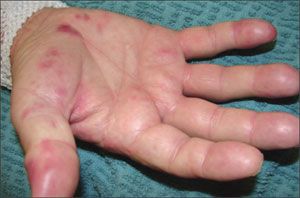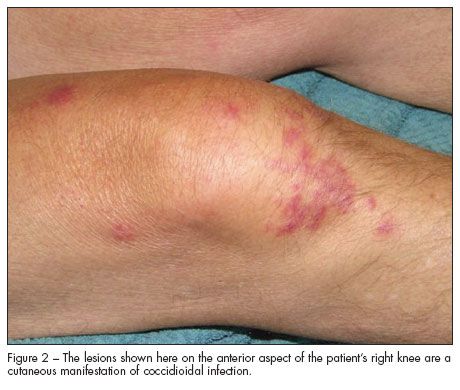Older Man With Fever and Tender Rash
For 1 week, a 77-year-old man had a fever and a tender, nonpruritic rash on both palms (Figure 1) and on the anterior aspect of both knees (Figure 2). Two weeks earlier, he had hives, which ameliorated after a 10-day course of cetirizine and a tapering course of prednisone. He also had headaches almost daily for the previous 6 to 8 weeks.

Figure 1
These painful, nonpruritic macules on the palm of a 77-yearold man are a manifestation of coccidioidomycosis.
For 1 week, a 77-year-old man had a fever and a tender, nonpruritic rash on both palms (Figure 1) and on the anterior aspect of both knees (Figure 2). Two weeks earlier, he had hives, which ameliorated after a 10-day course of cetirizine and a tapering course of prednisone. He also had headaches almost daily for the previous 6 to 8 weeks.
The patient had essential hypertension and an elevated prostate-specific antigen level, possibly caused by benign prostatic hypertrophy. He had no history of sexually transmitted disease or new sexual contacts. About 1 month earlier, he had taken prophylactic amoxicillin before a dental procedure on the recommendation of an emergency department (ED) physician who had detected a murmur.
Because the patient’s rash resembled Janeway lesions and Osler nodes, he was sent to the ED and was admitted for further evaluation. He continued to have intermittent fevers. Intravenous therapy with penicillin, nafcillin, and gentamicin was started for suspected subacute bacterial endocarditis. An echocardiogram showed mild aortic valve regurgitation but no valvular vegetations. Blood cultures were negative for bacteria.
The white blood cell count was 9700/μL, with no eosinophilia. The platelet count was 439,000/μL, hemoglobin level was normal, erythrocyte sedimentation rate was 63 mm/h, and electrolyte levels were normal. Results of liver and renal function tests, Lyme serologies, and HIV antibody tests were negative. Results of a rickettsial antibody panel were negative.
A skin biopsy revealed interstitial granulomatous dermatitis; this reactive eruption is often associated with coccidioidomycosis. The patient’s blood tested positive by immunodiffusion assay for Coccidioides IgM antibody, which reflected a recent infection. His disease did not disseminate. An exfoliative dermatitis developed within several days, and the lesions on his hands began to peel-a known sequela of coccidioidal infection. His recovery was otherwise uneventful.

COCCIDIOIDOMYCOSIS: AN OVERVIEW
In the southwestern United States, Mexico, and Central and South America, the dimorphic fungi Coccidioides immitis and Coccidioides posadasii can cause clinically significant mycosis1 after inhalation of a single arthroconidium.2 The fungi inhabit alkaline soil and become airborne when the soil is disturbed.
Although coccidioidal infection initiates in the lungs, it has a wide range of manifestations, including hemoptysis, urticaria, erythema nodosum, arthralgias, and prostatitis. Respiratory symptoms (eg, cough and dyspnea) may be absent, as in this patient. Infected persons often have nonspecific symptoms, such as fever, fatigue, and malaise. Coccidioidomycosis is commonly referred to as “valley fever.”

Clinically significant pulmonary manifestations include pneumonia. Coccidioidomycosis can be differentiated from other causes of pulmonary disease by an accompanying rash (eg, toxic erythema, urticaria, erythema nodosum, or erythema multiforme), which is present in 10% to 50% of affected patients.3 Although a rash predicts a favorable prognosis, it can complicate the clinical picture.
Patients with coccidioidomycosis often have eosinophilia and an elevated erythrocyte sedimentation rate. These findings can help distinguish valley fever from an upper respiratory tract infection.
Most cases of coccidioidomycosis resolve without complications, and drug therapy is not needed.4 Antifungal agents (eg, ketoconazole, fluconazole, and itraconazole) are more commonly required for immunocompromized persons who are at increased risk for complications, such as those with HIV infection, those receiving high-dose corticosteroid therapy, and organ transplant recipients who are taking immunosuppressants. Amphotericin B is reserved for the most severe cases of coccidioidal pneumonia.
References:
REFERENCES:1. Chiller TM, Galgiani JN, Stevens DA. Coccidioidomycosis. Infect Dis Clin North Am. 2003;17:41-57, viii.
2. Sun SH, Cole GT, Drutz DJ, Harrison JL. Electron-microscopic observations of the Coccidioides immitis parasitic cycle in vivo. J Med Vet Mycol. 1986;24:183-192.
3. Yozwiak ML, Lundergan LL, Kerrick SS, Galgiani JN. Symptoms and routine laboratory abnormalities associated with coccidioidomycosis. West J Med. 1988;149:419-421.
4. Galgiani JN. Coccidioidomycosis. West J Med. 1993; 159:153-171.
5. Desai SA, Minai OA, Gordon SM, et al. Coccidioidomycosis in non-endemic areas: a case series. Respir Med. 2001;95:305-309.